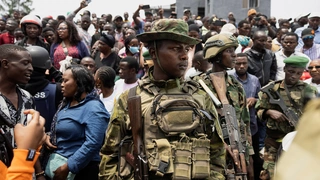Understanding the Renewed Conflict in the Democratic Republic of Congo
The eastern region of the Democratic Republic of Congo (DRC), rich in valuable minerals, has been mired in conflict for over three decades, a crisis that began with the Rwandan genocide in 1994. This period has seen various armed groups struggle against central governance, attempting to seize control of the wealth beneath the soil. The unrest has not only devastated the local population but has also drawn in neighboring countries, resulting in catastrophic humanitarian consequences.
Recent Developments and the M23 Rebel Group
Since the beginning of 2025, escalating violence has brought renewed attention to the DRC, particularly with the insurgent group known as M23 making significant territorial gains. Their most noteworthy victory occurred in late January when they seized Goma, a major city in North Kivu province with over a million residents. Positioned on the Rwandan border and near Lake Kivu, Goma serves as a crucial economic and logistical center, providing access to mining areas vital for resource extraction.
In February, M23 captured Bukavu, the capital of South Kivu province, further complicating the local security landscape. Despite ongoing clashes with the Congolese army and allied militia, the group continues its aggressive push for territorial expansion, even threatening the capital city, Kinshasa, located 2,600 kilometers away.
Who are the M23?
The M23 is largely composed of ethnic Tutsis, who argue that they have taken up arms to defend their rights amid persistent violations. The group claims its name from a peace accord signed on March 23, 2009, following previous conflicts involving Tutsi-led factions. After a rapid rise to power in 2012, including the capture of Goma, international backlash ensued, with accusations of war crimes driving the group into retreat. Later, in 2021, the M23 reemerged, citing unfulfilled promises regarding Tutsi protection from Congolese authorities as the catalyst for its resurgence.
Rwanda’s Alleged Role in the Conflict
Leaders of the M23, including Sultani Makenga, who has prior military experience with the Rwandan army, have consistently denied direct support from the Rwandan government. Nevertheless, reports from UN experts indicate that Rwandan troops have been actively engaged alongside M23 forces since 2012. In 2022, a UN report estimated that up to 4,000 Rwandan soldiers were operating in DRC, a claim the Rwandan government refutes, arguing it is merely protecting its borders.
Historically, the conflict in the DRC has its roots in the aftermath of the Rwandan genocide, which saw a mass exodus of Hutu militants into DRC, exacerbating ethnic tensions. Rwanda has accused remnants of the genocidal regime, specifically the Democratic Forces for the Liberation of Rwanda (FDLR), of posing a threat to its security.
Pathway to Peace?
Efforts for a peaceful resolution have recently gained momentum, with several key developments taking place. In March, Congolese President Félix Tshisekedi and Rwandan President Kagame emphasized the necessity of an immediate ceasefire following direct talks in Qatar. By late April, both governments agreed to halt fighting while mediating peace talks continued.
| Date | Event |
|---|---|
| March 18, 2025 | Ceasefire call between Congo and Rwanda after Qatar talks. |
| April 23, 2025 | Agreement to pause fighting in Eastern DRC until peace talks are finalized. |
| April 25, 2025 | DR Congo and Rwanda sign US-mediated agreement on sovereignty. |
Despite these advances toward peace, sporadic fighting continues, with M23 expanding its control in South Kivu province. With the US eager to negotiate mineral deals with both nations, hopes for a regional ceasefire remain precarious.


